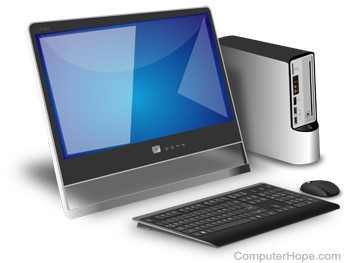Desktop computer

A desktop computer is a computer that fits on or under a desk. They utilize peripheral devices for interaction, such as a keyboard and mouse for input, and display devices like a monitor, projector, or television. Desktop computers can have a horizontal or vertical (tower) form factor, or be combined with a monitor to create an All-in-One computer. Unlike a laptop, which is portable, desktop computers are generally made to stay at one location.
Desktop computer overview
Below is a picture of the main parts (components) that help make up a computer. In the picture, you can see a desktop computer, flat-panel display, speakers, keyboard, and mouse. We've also labeled each of the input devices and output devices.

When did the first desktops appear?
The first desktop computer was the Hewlett Packard 9100A, introduced in 1968. Since then, there were many millions of desktop computers released and used throughout the world.
There is not a specific person who is responsible for creating the desktop computers we use today. Over their evolution, many individuals and companies have made significant contributions. For a complete history of computers, see: When was the first computer invented?
Where should I place my desktop computer?
Most users put their computer on the floor next to or under their desk. However, as long as your monitor and other devices can communicate with the computer, it can go anywhere. The sections below contain pros and cons of different desktop computer placement locations.
Desktop computer on the floor
Advantages
- Keeps the computer desk clean with more space available.
- Usually cooler on the floor, which helps keep the computer cooler.
Disadvantages
- More difficult to connect cables and drives, and insert discs into the computer.
- Easier to mistakenly kick and access by children.
- Cables may not be long enough for you to place the computer where you want on the floor.
- More dust and hair on the floor can get into the computer.
Desktop computer on the desk
Advantages
- Easier to connect cables and drives, and insert discs into the computer.
- Harder to access by small children.
- Allows you to show off a computer.
Disadvantages
- More noise if the computer has fans, which can interrupt recording on a microphone or make it harder to hear sound from speakers.
Desktop computer in a drawer or cabinet
When placing a desktop computer in any confined space, it must have enough room around the case for proper airflow. As the computer is used, it generates heat and needs the ability to bring in cool air and blow out hot air.
Advantages
- Keeps computer desk and floor clean.
- Less dust, dirt, and hair gets into the computer.
Disadvantages
- Can cause excessive heat without proper air flow.
- More difficult to connect cables and drives, and insert discs into the computer.
Does anyone still use a desktop computer?
Yes, desktop computers are still used by millions of people every day. Although other types of computers, like laptops, tablets, and smartphones, have become a popular alternative, desktop computers are still used by schools, businesses, and gamers.
Chassis, Computer, Hardware terms, Home computer, Keyboard, Monitor, Mouse, Tower
